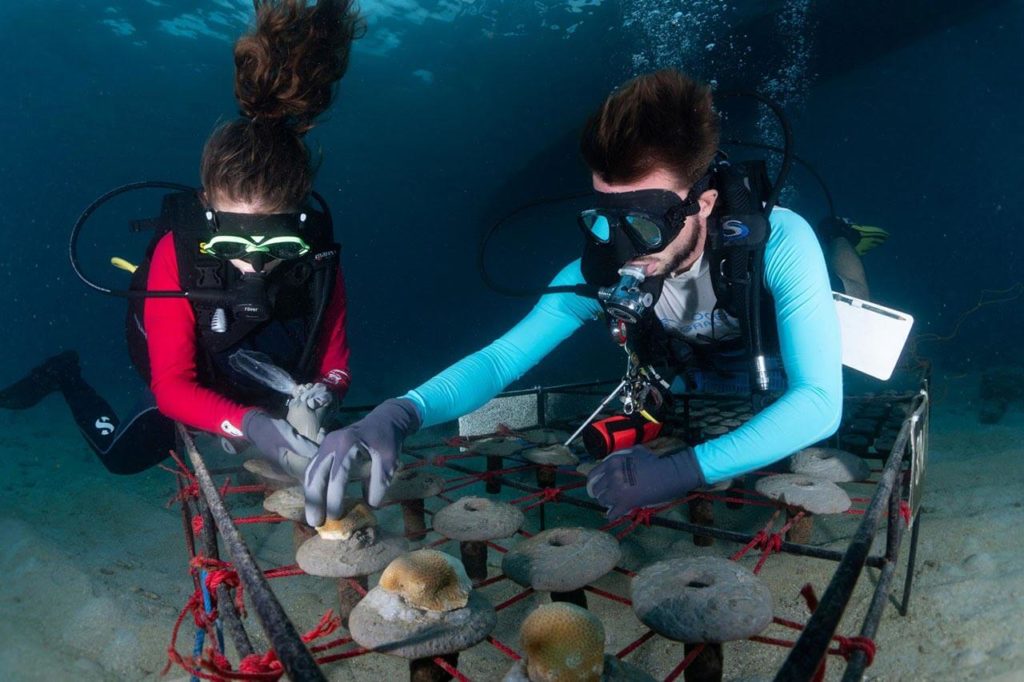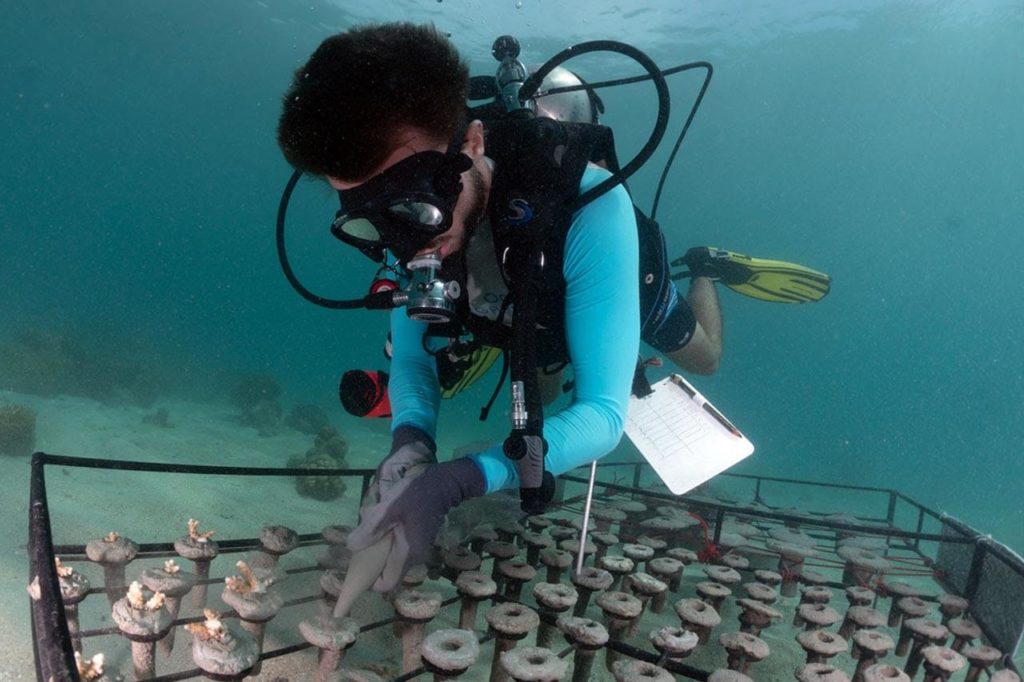Some people find it surprising that corals, the colourful, rock-like wonders you find on sea floors, are really animals! As corals are transfixed on the seafloor and remain in the same place, they are often mistaken for a plant.
But oh, they are much more complex than that. Think about corals as the rainforests of the ocean. Coral reefs protect coastlines from storms and erosion, provide jobs for local communities, and offer opportunities for recreation. They are also a source of food and new medicines. Over half a billion people depend on reefs for food, income, and protection.
Scientists fear between 70% and 90% of the Earth’s coral reefs — which support a quarter of all marine species on the planet — will be destroyed by 2050 due to the warming of the oceans. But efforts are underway to change this.
Sustainable coral farming practices is one of these effective efforts!
What is Sustainable Coral Farming?
Sustainable coral farming is the practise of farming using principles of ecology. In other words, it is the study of relationships between organisms and their environment. It’s not just all about farming and replanting corals, it’s about farming the right species in the right environment.
Indonesia, the country with the most reef area, has 51,000 square kilometers of coral reefs. With some of the richest biodiversity in the world, there are many corals to consider when planting and farming. Even though we have kilometers of coral reefs around us, that doesn’t mean that they’re not in danger. As divers, we want to take care of the beautiful ocean environment around us. Coral Farming is part of that care process.
Indonesia, the country with the most reef area, has 51,000 square kilometers of coral reefs. With some of the richest biodiversity in the world, there are many corals to consider when planting and farming. Even though we have kilometers of coral reefs around us, that doesn’t mean that they’re not in danger. As divers, we want to take care of the beautiful ocean environment around us. Coral Farming is part of that care process.


How does farming corals work?
What is the purpose of farming corals in the first place? This is a process of collecting coral fragments, raising them in carefully-tended nurseries and replanting them on restoration sites. Once they’re installed on the dying reefs, they can then overpower or even protect the dying one.
Coral fragments fall off of their parent corals when they get sick, hit by diver’s fins, or by other external factors. Divers search for these fragments on the ocean floor, looking for signs that they can be rehabilitated. Once we find these fragments, they are then replanted onto coral tables. These coral tables are split in two, on one side you have the mother colony, from which we will cut small fragments to fill the other side of the table which we refer to as the baby colony. When the babies have reached a size of 6 or 7 cm we are able to pick them up and re-plant them back onto the reef. At that point we start the process of clipping coral fragments of the mother colony again. These tables are self-producing corals which makes these coral nurseries all the more sustainable!
Coral fragments fall off of their parent corals when they get sick, hit by diver’s fins, or by other external factors. Divers search for these fragments on the ocean floor, looking for signs that they can be rehabilitated. Once we find these fragments, they are then replanted onto coral tables. These coral tables are split in two, on one side you have the mother colony, from which we will cut small fragments to fill the other side of the table which we refer to as the baby colony. When the babies have reached a size of 6 or 7 cm we are able to pick them up and re-plant them back onto the reef. At that point we start the process of clipping coral fragments of the mother colony again. These tables are self-producing corals which makes these coral nurseries all the more sustainable!
Most coral farms build nurseries on shallow ocean floors with plenty of sunlight exposure, much like an underwater garden.
The waters around Gili Air are PERFECT for rehabilitating corals. With many different species of hard and soft corals, as well as ample space to be able replant them in the correct conditions.
Newfound farming techniques can speed up the natural coral growth rate by up to 50 times. Corals that used to take decades to grow can now do so in months. All in all, coral farming is a great solution to reverse the destruction and death of the ocean’s richest ecosystem.
We have a chance here to create real change in the underwater world. Change that inevitably affects our world on land as well.
The waters around Gili Air are PERFECT for rehabilitating corals. With many different species of hard and soft corals, as well as ample space to be able replant them in the correct conditions.
Newfound farming techniques can speed up the natural coral growth rate by up to 50 times. Corals that used to take decades to grow can now do so in months. All in all, coral farming is a great solution to reverse the destruction and death of the ocean’s richest ecosystem.
We have a chance here to create real change in the underwater world. Change that inevitably affects our world on land as well.


How do you choose which corals get planted?
Upon first glance, a lot of soft and hard corals look pretty much the same. They differ in color or size, but not much else.
Corals are complex, differing in their ability to fight infections (such as bleaching), to reproduce, and to resist the warming of the oceans. A well planted, diverse reef is the key to help save these underwater forests. Where there is high diversity, there is strength.
Corals are complex, differing in their ability to fight infections (such as bleaching), to reproduce, and to resist the warming of the oceans. A well planted, diverse reef is the key to help save these underwater forests. Where there is high diversity, there is strength.
Some corals grow very quickly, some are less prone to disease, some bleach less, some are hardier during storms. There’s not one coral species or individual that excels across the board, so we must focus on creating high levels of coral diversity.
All of this requires careful planning. It takes time to research and get to know the varieties of corals in our area. Corals are chosen based on a few different factors. First is how healthy the coral fragment is, how likely it is to recover. Another, as mentioned above, is figuring out which corals will add to a healthy amount of diversity in the reefs. We need to ensure a healthy balance, and this is where identifying different species to add to coral gardens is important.
All of this comes together in fundamental reasons why divers should be trained in coral reef restoration.
All of this comes together in fundamental reasons why divers should be trained in coral reef restoration.
Coral Indo Conservation Initiative
Here on Gili Air, at 3W Dive, we’ve started a special partnership and restoration initiative with
an NGO called Coral Indo Conservation.
Coral Indo Conservation specializes in education and restoration of corals.
Coral Indo Conservation uses various species of corals and different nursery and reef restoration methods depending on location and needs of the reef being.


Learn about coral
Our tribe is passionate about the ocean and corals. We understand that without coral reefs, not only will the diving that we love cease to exist, it would change the lives of everyone on planet earth.
While many divers are very knowledgeable about fishes that they dive with and the act of diving itself. However many divers are unaware of the foundations of a coral reef ecosystem. For example, how to identify corals, coral diseases, and the potential dangers that they face.
Our 3-day Coral Diver course takes you into the fascinating world of coral reef restoration. If you have an interest in marine biology and conservation and want to improve your knowledge of corals, this is a program for you.
You’ll have 5 coral dives and learn more about what you’re seeing in the ocean, all while contributing to the health of our reefs and our marine conservation efforts in the Gilis.
There is another option for those interested in becoming an ocean steward as well as a divemaster. Our Marine Conservation Divemaster Internship! During the Marine Conservation Internship, interns will help in monitoring the ongoing coral restoration project, learning even more about the ocean and ocean conservation.
Are you ready to join our tribe and help the ocean? Visit this page to get more information and join us!


